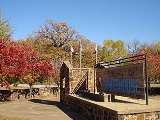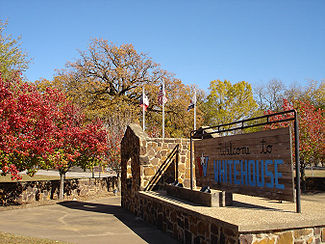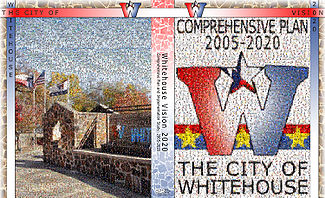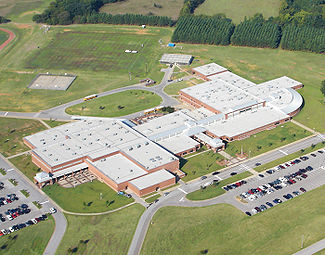
Whitehouse, Texas
Encyclopedia
Whitehouse is a city in Smith County
, Texas
, United States
. The city had an estimated population of 7,327 in 2006. It is part of the Tyler, Texas
Metropolitan Statistical Area.
is located approximately seven miles to the north, while the City of Troup, Texas
lies roughly the same distance to the south.
According to the United States Census Bureau
, the city has a total area that exceeds 3.8 square miles (9.8 km²), all of it land. The city's extra territorial jurisdiction includes land surrounding Lake Tyler, a large water body used for drinking water and recreation by East Texas residents.
of 2000, there were 5,346 people, 1,819 households, and 1,500 families residing in the city. The population density
was 1,413.6 people per square mile (546.1/km²). There were 1,890 housing units at an average density of 499.8 per square mile (193.1/km²). The racial makeup of the city was 93.14% White, 2.47% African American, 0.64% Native American, 0.86% Asian, 1.78% from other races
, and 1.12% from two or more races. Hispanic or Latino of any race were 3.98% of the population.
There were 1,819 households out of which 50.4% had children under the age of 18 living with them, 66.2% were married couples
living together, 13.5% had a female householder with no husband present, and 17.5% were non-families. 14.7% of all households were made up of individuals and 5.3% had someone living alone who was 65 years of age or older. The average household size was 2.88 and the average family size was 3.20.
In the city the population was spread out with 32.4% under the age of 18, 7.1% from 18 to 24, 33.1% from 25 to 44, 18.8% from 45 to 64, and 8.5% who were 65 years of age or older. The median age was 32 years. For every 100 females there were 91.9 males. For every 100 females age 18 and over, there were 84.6 males.
The median income for a household in the city was $46,804, and the median income for a family was $49,393. Males had a median income of $36,891 versus $22,334 for females. The per capita income
for the city was $17,489. About 6.7% of families and 8.6% of the population were below the poverty line, including 13.5% of those under age 18 and 5.7% of those age 65 or over.
 The community was founded long before the city was officially incorporated. The community was named in 1845, but was not incorporated until 1953. The school district (WISD) preceded incorporated municipal government, and was largely responsible for the eventual formation of the city.
The community was founded long before the city was officially incorporated. The community was named in 1845, but was not incorporated until 1953. The school district (WISD) preceded incorporated municipal government, and was largely responsible for the eventual formation of the city.
Residents of Whitehouse were predominantly farmers or worked in support of agriculture until transportation innovations following World War II lead to other employment options. Many streets and subdivisions in the community are named for these early agricultural and commercial leaders.
According to oral tradition, the community was named "Whitehouse" by the railroad engineers who stopped near a white-washed community building during early settlement times. Several cherished historic resources include the various Works Progress Administration
(WPA) projects located within the city. These projects, typically built with sandstone rockwork, are found throughout the city's historic Town Center.
 Whitehouse is in the first phase of an overhaul of its planning regulations. The city initially began regulating land use through zoning on December 4, 1987. The next major effort intended to improve quality of life in the city through planning was the completion of the community's first comprehensive plan in April 1996. The document was developed by J.T. Dunkin & Associates.
Whitehouse is in the first phase of an overhaul of its planning regulations. The city initially began regulating land use through zoning on December 4, 1987. The next major effort intended to improve quality of life in the city through planning was the completion of the community's first comprehensive plan in April 1996. The document was developed by J.T. Dunkin & Associates.
 The city is served by the Whitehouse Independent School District
The city is served by the Whitehouse Independent School District
. The district consists of seven schools located on six campuses. The campuses include:
The district is well regarded throughout the East Texas region and is one factor contributing to the city's strong growth rate. Recognitions for the district include the "One of BScene's Best" award for two straight years.
Stanton-Smith Elementary school is a more recent addition to the Whitehouse ISD campuses. It has been added to meet the needs of population growth within the city, with more efficient classroom space.
Smith County, Texas
As of the census of 2000, there were 174,706 people, 65,692 households, and 46,904 families residing in the county. The population density was 188 people per square mile . There were 71,701 housing units at an average density of 77 per square mile...
, Texas
Texas
Texas is the second largest U.S. state by both area and population, and the largest state by area in the contiguous United States.The name, based on the Caddo word "Tejas" meaning "friends" or "allies", was applied by the Spanish to the Caddo themselves and to the region of their settlement in...
, United States
United States
The United States of America is a federal constitutional republic comprising fifty states and a federal district...
. The city had an estimated population of 7,327 in 2006. It is part of the Tyler, Texas
Tyler, Texas
Tyler is a city in and the county seat of Smith County, Texas, in the United States. It takes its name from President John Tyler . The city had a population of 109,000 in 2010, according to the United States Census Bureau...
Metropolitan Statistical Area.
Geography
Whitehouse is located at 32°13′24"N 95°13′3"W (32.223443, -95.217579). The city is bisected by State Highway 110 and Farm to Market Road 346. The City of Tyler, TexasTyler, Texas
Tyler is a city in and the county seat of Smith County, Texas, in the United States. It takes its name from President John Tyler . The city had a population of 109,000 in 2010, according to the United States Census Bureau...
is located approximately seven miles to the north, while the City of Troup, Texas
Troup, Texas
Troup is a city in Cherokee and Smith Counties in the U.S. state of Texas. The population was 1,949 at the 2000 census. Troup is the 2nd community to legalize Beer, Wine, and Liquor for retail sale in Smith County since 1939, just 2nd to Winona, that legalized back in 2010.Troup lies in two...
lies roughly the same distance to the south.
According to the United States Census Bureau
United States Census Bureau
The United States Census Bureau is the government agency that is responsible for the United States Census. It also gathers other national demographic and economic data...
, the city has a total area that exceeds 3.8 square miles (9.8 km²), all of it land. The city's extra territorial jurisdiction includes land surrounding Lake Tyler, a large water body used for drinking water and recreation by East Texas residents.
Demographics
As of the censusCensus
A census is the procedure of systematically acquiring and recording information about the members of a given population. It is a regularly occurring and official count of a particular population. The term is used mostly in connection with national population and housing censuses; other common...
of 2000, there were 5,346 people, 1,819 households, and 1,500 families residing in the city. The population density
Population density
Population density is a measurement of population per unit area or unit volume. It is frequently applied to living organisms, and particularly to humans...
was 1,413.6 people per square mile (546.1/km²). There were 1,890 housing units at an average density of 499.8 per square mile (193.1/km²). The racial makeup of the city was 93.14% White, 2.47% African American, 0.64% Native American, 0.86% Asian, 1.78% from other races
Race (United States Census)
Race and ethnicity in the United States Census, as defined by the Federal Office of Management and Budget and the United States Census Bureau, are self-identification data items in which residents choose the race or races with which they most closely identify, and indicate whether or not they are...
, and 1.12% from two or more races. Hispanic or Latino of any race were 3.98% of the population.
There were 1,819 households out of which 50.4% had children under the age of 18 living with them, 66.2% were married couples
Marriage
Marriage is a social union or legal contract between people that creates kinship. It is an institution in which interpersonal relationships, usually intimate and sexual, are acknowledged in a variety of ways, depending on the culture or subculture in which it is found...
living together, 13.5% had a female householder with no husband present, and 17.5% were non-families. 14.7% of all households were made up of individuals and 5.3% had someone living alone who was 65 years of age or older. The average household size was 2.88 and the average family size was 3.20.
In the city the population was spread out with 32.4% under the age of 18, 7.1% from 18 to 24, 33.1% from 25 to 44, 18.8% from 45 to 64, and 8.5% who were 65 years of age or older. The median age was 32 years. For every 100 females there were 91.9 males. For every 100 females age 18 and over, there were 84.6 males.
The median income for a household in the city was $46,804, and the median income for a family was $49,393. Males had a median income of $36,891 versus $22,334 for females. The per capita income
Per capita income
Per capita income or income per person is a measure of mean income within an economic aggregate, such as a country or city. It is calculated by taking a measure of all sources of income in the aggregate and dividing it by the total population...
for the city was $17,489. About 6.7% of families and 8.6% of the population were below the poverty line, including 13.5% of those under age 18 and 5.7% of those age 65 or over.
Early History

Residents of Whitehouse were predominantly farmers or worked in support of agriculture until transportation innovations following World War II lead to other employment options. Many streets and subdivisions in the community are named for these early agricultural and commercial leaders.
According to oral tradition, the community was named "Whitehouse" by the railroad engineers who stopped near a white-washed community building during early settlement times. Several cherished historic resources include the various Works Progress Administration
Works Progress Administration
The Works Progress Administration was the largest and most ambitious New Deal agency, employing millions of unskilled workers to carry out public works projects, including the construction of public buildings and roads, and operated large arts, drama, media, and literacy projects...
(WPA) projects located within the city. These projects, typically built with sandstone rockwork, are found throughout the city's historic Town Center.
YesterYear Celebration
Civic leaders established the YesterYear Celebration to educate residents about the community's history and heritage. The festival is held on the fourth weekend each June and includes activities such as parades, carnivals, historic reenactments, pageants, and trade days.Historic Reading
Several works documenting the community's history have been published in the recent past. Shirley Smith wrote and/or edited several books including Homefolks, a collection of letters from important figures who lived in the community throughout the early 20th century. The Tri-County Leader published a series of articles by Acker Hanks called "Growing up in Whitehouse." The articles recounted Mr. Hanks' experience in the community starting in the early 1920s. The Whitehouse Vision 2020 Comprehensive Plan (see Planning and Development) also included a history section. This section was based on oral history interviews from prominent Whitehouse residents such at Nancy Shahan Coats, Joe Pat Hagan, Acker Hanks, and Richard Waller. Many of these resources are available at the Whitehouse Community Library.Past Efforts

Recent Efforts
The city's Planning & Zoning Commission has worked at the direction of the City Council to update various components of the 1987 zoning ordinance. The commission also recommended updates to the subdivision regulations which were adopted in February 2004. The city also contracted with Butler Planning Services to update the comprehensive plan from 1996. The firm, along with a citizen steering committee, produced the Whitehouse Vision 2020 Comprehensive Plan in the spring of 2006. Following this effort, the city is currently evaluating the need for a new zoning ordinance which can implement the recommendations of the Vision 2020 Plan.Education

Whitehouse Independent School District
The Whitehouse Independent School District is a school district in Whitehouse, Texas, United States.In 2009, the school district was rated "academically acceptable" by the Texas Education Agency.-School Campuses:*Whitehouse High School...
. The district consists of seven schools located on six campuses. The campuses include:
- Cain Elementary School
- Mozelle Brown Elementary School
- Higgins Elementary School
- Stanton-Smith Elementary School
- Holloway Middle School
- Whitehouse Junior High School
- Whitehouse High School
- AIM Center
- Bus Barn
The district is well regarded throughout the East Texas region and is one factor contributing to the city's strong growth rate. Recognitions for the district include the "One of BScene's Best" award for two straight years.
Stanton-Smith Elementary school is a more recent addition to the Whitehouse ISD campuses. It has been added to meet the needs of population growth within the city, with more efficient classroom space.

